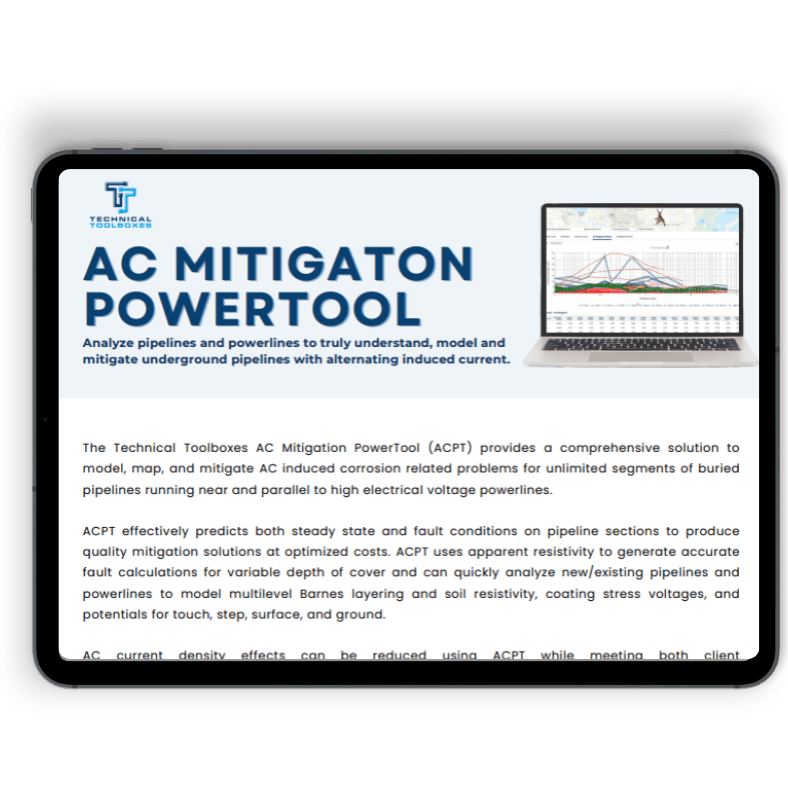Explore Advanced Pipeline Safety with the AC Mitigation PowerTool
Dive into the sophisticated realm of pipeline safety and corrosion prevention with our AC Mitigation PowerTool (ACPT) Infographic. This comprehensive visual guide takes you from identifying the challenges posed by AC-induced corrosion in underground pipelines to deploying advanced mitigation techniques that safeguard pipeline integrity against alternating induced currents from nearby high-voltage power lines.
Why Focus on AC-Induced Corrosion and Corrosion Prevention?
AC-induced corrosion is a significant threat to the longevity and safety of pipelines. It occurs when pipelines are subjected to alternating currents from nearby electrical power lines, which can accelerate corrosion rates. Effective corrosion prevention and mitigation are crucial to maintaining the structural integrity and operational efficiency of pipelines.
Key Highlights of the ACPT Infographic:
- Innovative Solution: The AC Mitigation PowerTool revolutionizes corrosion prevention and AC mitigation with detailed modeling and comprehensive reporting capabilities. It provides a strategic approach to identifying and mitigating the effects of AC-induced corrosion, ensuring the long-term safety of pipelines.
- Intuitive Design: With a user-friendly interface, the ACPT enhances accessibility and efficiency in planning and executing AC mitigation strategies. This intuitive design allows engineers to quickly model and assess the impact of various mitigation techniques.
- Cost Efficiency: The ACPT identifies optimal design and mitigation strategies that prevent future catastrophic events, significantly reducing field time and associated costs. By implementing effective corrosion prevention methods, companies can avoid costly repairs and downtime.
- Simulation Excellence: Offering advanced capabilities to model complex scenarios, the ACPT can simulate multiple powerline impacts and variable soil resistivities. This allows for a precise analysis of potential AC-induced corrosion issues and the development of tailored mitigation plans.
Practical Applications and Benefits:
- Design Optimization: Engineers can use the ACPT to optimize pipeline designs, incorporating effective AC mitigation techniques from the outset. This proactive approach minimizes the risk of corrosion-related failures and extends the lifespan of the pipeline infrastructure.
- Real-Time Monitoring and Adjustment: The ACPT allows for real-time monitoring of pipeline conditions and the effectiveness of mitigation measures. This capability ensures that any emerging corrosion issues are promptly addressed, maintaining continuous pipeline integrity.
- Regulatory Compliance: The ACPT helps companies comply with industry regulations and standards related to pipeline safety and corrosion prevention. By ensuring adherence to these guidelines, companies can avoid legal and financial repercussions.
- Training and Development: The ACPT serves as a valuable training tool for new engineers, providing hands-on experience in modeling and mitigating AC-induced corrosion. This enhances the skill set of the engineering team and ensures that best practices are consistently applied.
This One-Pager emphasizes the pivotal role of the AC Mitigation PowerTool in advancing pipeline safety through technological innovation. It showcases the tool’s ability to model, map, and mitigate AC-induced corrosion challenges with precision and ease, setting a new standard in pipeline integrity management. By focusing on user-friendly design, cost-saving strategies, and sophisticated simulation capabilities, the ACPT proves to be an indispensable asset for modern pipeline engineering.



